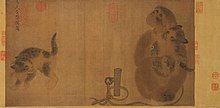
Yi Yuanji (Chinese: 易元吉; Wade-Giles: I Yüan-chi) (c. 1000, Changsha, Hunan[1] – c. 1064) was a Northern Song dynasty painter, famous for his realistic paintings of animals. According to Robert van Gulik, Yi Yuanji's paintings of gibbons were particularly celebrated.[2] [3]
The 11th-century critic Guo Ruoxu (郭若虚) in his Overview of Painting (图画见闻志, Tuhua Jian Wen Zhi) tells this about Yi's career:[4][5]
... His painting was excellent: flowers and birds, bees and cicadas he rendered life-like with subtle detail. At first he specialized in flower and fruit, but after he had seen such paintings by Zhao Chang (趙昌), he admitted their superiority with a sigh, and then resolved he would acquire fame by painting subjects not yet tried by the artists of old; thus he began to paint roebucks and gibbons.
He spent months roaming the mountains of southern Hubei and northern Hunan, watching roebucks (獐鹿) and gibbons (猿狖) in their natural environment.[2]

In 1064, Yi Yuanji was invited to paint screens in the imperial palace. Once this job has been completed, the Yingzong Emperor, impressed, commissioned him to paint the Picture of a Hundred Gibbons, but the artist died after painting only a few gibbons.[1][2] A few of his other gibbon paintings have survived, and Robert van Gulik, quite familiar with the behavior of this ape, comments on how naturally they look in the pictures.[2] His other work includes depictions of deer, peacocks, birds-and-flowers and fruits-and-vegetables; many of them are kept in the National Palace Museum in Taipei.[1] The Monkey and Cats painting is especially charming.[6] Van Gulik identifies the monkey as a macaque.[2] This painting was featured on a 2004 "Year of the Monkey" stamp from Saint Vincent and the Grenadines.[7]
The image of Yi Yuanji, with his intimate knowledge of nature, has attracted attention from modern Chinese painters.[8]
- ^ a b c I Yüan-chi
- ^ a b c d e Van Gulik, Robert Hans (1967), The gibbon in China: An essay in Chinese animal lore, E. J. Brill, Leiden, Holland. There is a brief summary at [1]
- ^ Thomas Geissmann, Gibbon paintings in China, Japan, and Korea: Historical distribution, production rate and context" . Gibbon Journal, No. 4, May 2008.
- ^ English translation by Van Gulik, in Van Gulik (1967), p. 79
- ^ Guo Ruoxu. (in Chinese) – via Wikisource.
- ^ MASTERPIECES OF CHINESE ART, Time Magazine, May 6, 1957
- ^ Feline Philately: Cats on stamps
- ^ Painting by modern artist Fan Zeng (范曾) Yi Yuanji playing with a monkey (易元吉戏猴图)", painting by the modern Chinese artist Fang Zeng (范曾)